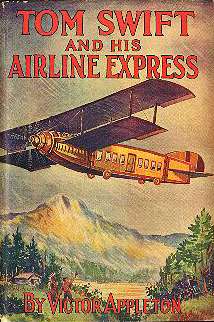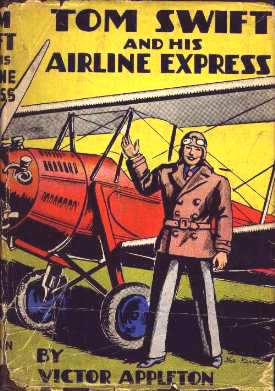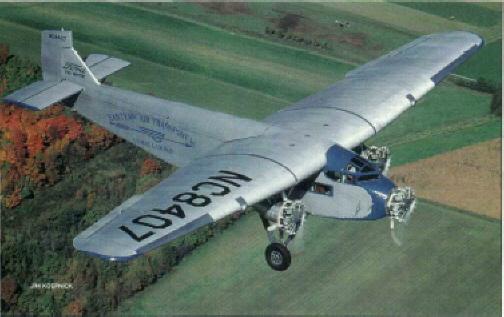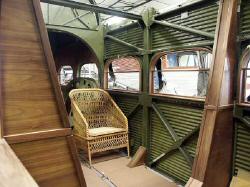 Note:
some of the language, references & attitudes, while acceptable at the time they
were written, are not Politically Correct, today.
Note:
some of the language, references & attitudes, while acceptable at the time they
were written, are not Politically Correct, today.Tom Swift and His Airline Express
or, From Ocean to Ocean by Daylight
By Victor Appleton ©1926 Book #29
Review by JP Karenko, October 2005
 Note:
some of the language, references & attitudes, while acceptable at the time they
were written, are not Politically Correct, today.
Note:
some of the language, references & attitudes, while acceptable at the time they
were written, are not Politically Correct, today.
Summary:
No official summary was ever provided with any of the old Tom Swift books. However, without giving too much away, the plot can be summed up as follows:
The neighborhood is still in the hand-basket headed for Hell. This is another tale of industrial espionage, extortion and theft. In spite of Swift Construction's electric fences, alarms, watchmen and guarded gates, Tom is waylaid, drugged, shackled and beaten by a couple of disgruntled ex-employees in cahoots with the "Hooded Two." These miscreants seem to think that Tom's latest brainchild, The AirLine Express, is their idea and try to prevent Tom's success by various nefarious means. This revolutionary concept will allow travel from coast to coast in a single 16 hour day, using a concept for all purposes similar to the old Pony Express, but with wings.
In addition, to criminal human factors, there are the usual hazards of air travel to be overcome: foul weather, mechanical breakdowns, fire and a pair of quarrelsome stewardess-wannabes, Rad and Koku. ( Lost luggage has not yet been invented.)
How these problems are resolved, you will have to locate a hard cover copy of the book to find out.
I have been unable to find this story on line. Sorry.
![]()
Cast of Characters (More or less in order of appearance)
 Tom
Swift-Intrepid
inventor & mechanic. Plucky, lively, resourceful, brave and clever.
Home-schooled at a college level by his father, Barton Swift. Athlete and
hunter. Familiar with how to stalk game and firearms. Loves all things
mechanical. In this tale we find his pockets contain metalworking files and
chocolate.
Tom
Swift-Intrepid
inventor & mechanic. Plucky, lively, resourceful, brave and clever.
Home-schooled at a college level by his father, Barton Swift. Athlete and
hunter. Familiar with how to stalk game and firearms. Loves all things
mechanical. In this tale we find his pockets contain metalworking files and
chocolate.
Trapdoor Ted, the Khloroform Kid-No name or description. Likely one of the Gang of Four. Never positively identified. See below.
Ned Newton-Chum & companion of Tom. No description given. He continues in his position as Swifts' financial advisor and CFO (Treasurer) of Swift Construction Company. In this tale, he has once again moved into the Swift manse.
The Gang of Four: -or two, or five... See below.
Kenny-NLN or description. Ex-Swift employee, discharged "because Tom didn't like his looks."
Schlump-NFN or description. Ex-Swift employee, discharged "because Tom didn't like his looks."
Masked Marauder 1-No name or description, except knows Blodgett.
Masked Marauder 2- No name or description, except knows Blodgett.
Lonely House Guy- No name or description. See also, below.
Mrs. Baggert-Swift's aged housekeeper. In this tale, she is back to her usual demure and practical self. No longer the hysteric of the previous episode.
Barton Swift-Widower. Wealthy and conservative. Inventor, master machinist and holder of numerous patents. In this episode, he is described simply as aged. Mr. Swift, has enjoyed improved health of late, and is now working on a book about inventing. We also find he wears glasses. Not surprising for someone of his advanced years. On the dust jacket of Chest of Secrets, his appearance is remarkably like that of Robert E. Lee.
Miss Mary Nestor-Betrothed love interest of Tom who lives on the east side of Shopton. Described as a "very pretty young woman with flashing brown eyes, and a sweet trilling laugh." Blushes easily, especially around Tom. Also described as "plucky."
In this tale, makes an overnight trip with Tom to Washington DC, in violation of the 1910 Mann Act. (Hanging out with an inventor would be considered "debauchery" in those days...)
Koku-Giant manservant of Tom. Devoted, loyal, and possessed of great strength, but apparently somewhat limited cognitive facilities. Described as "savage and only half-tame," he is antagonist and rival of Eradicate. In this episode, he is nothing but comic relief, antagonizing and scrapping with Rad.
Eradicate Andrew Jackson Abraham Lincoln Sampson, A.K.A. Rad-Aged stereotypical Negro manservant. "Eradicates dirt." Eradicate has now "become too old to do much," As described, he now has "white hair in a fringe and is bald on top..." He remains faithful to Tom and helps out where he can. Constant rival and antagonist of giant Koku. In this tale, he nearly sets the aircraft on fire, when his pie burns up in the on-board galley.
Mr. (Amos) Nestor-Mary's father. In spite of major roles in several of these adventures, his description is never given, and his first name was only mentioned in passing, in episodes #1 and #6. Walk-on part in this tale.
Mr. Wakefield Damon-Elderly & eccentric adventurer whose main purpose in life seems to be blessing everybody and everything near his person. Never fully described, except as "portly" with a moustache and "tortoise-shell glasses." Appears to be quite wealthy. Back to his old hobby of crashing things, again. This time, he bends a brand-new airplane around the dirigible mooring mast on Swift Construction's airfield.
Greasy Spoon Gus-Chef de Cuisine at an all-night eatery in Waterfield. Keeps a revolver on hand to discourage robbery ( or complaints about his cooking? ) Walk-on part.
The Lonely House Guy- No name or description, except as a 5th cohort of the "Masked Two"/ Gang of Four. See below and above. Walk-on part.
David Knowlton-No description, except a farmer who takes in a disheveled and injured stranger (Tom). Willing to brandish a shotgun to prevent bad guys from recapturing Tom.
Sarah Knowlton- No description, except kind and solicitous farmer's wife.
Dr. Prouty-No first name or description. One of many typical faceless medical men that seem to pervade the Shopton area. Practices in Birchville, NY.
Hired Hand Hank - No actual name or description given. Works for Knowltons. Walk-on part.
Nasty Nasal Number-Please Nancy- No actual name or description given. Semi-snotty telephone operator, who is reluctant to try and trace a call made by Tom.
Bob, the Bell Boss- No actual name or description given. Nasty Nancy's supervisor. Wants to help trace Tom's call, but is hampered by the technology of the times.
Damon's Domestic, Debbie- No actual name or description given. This twit lets bad guys into the Damon household, unannounced. Walk-on part. Soon to be unemployed, I suspect.
Soliciting Stranger Sam- No actual name or description given. Enters Damon's domicile on the pretext of looking for employment. Bad guy. Suspected cohort of "Masked Two."
General Malcolm-NFN or description. Washington chair-warmer who is "an old friend" of Barton Swift. Attempts to get Tom's patent application moving through the already semi-ossified bureaucracy in the USG/Patent Office.
Helen Morton-No description, except friend of Mary Nestor. Hangs with and on Ned Newton. Future love interest of same.
Jason Jacks-Old fashioned, aged, homely, toothless and ornery Shopton millionaire. Just happens to be around and in need of rescue, when Tom could use a few shekels to get his new invention's prototype built. Has no use for modern machinery.
Paulie, the Plunging Palomino Pony-Runs away with Jason Jacks on a mountain road. Ends up as dog food at the bottom of a ravine, for his efforts. Note to the PETA types: At least one animal was injured and killed in the making of this story. Nobody bothered reporting it...I also suspect Mary Nestor wears fur.
The "Masked Two"-Revealed in the final chapter as Blodgett and Fawn, the bad guys from Chest of Secrets. They are the ringleaders of the gang supposedly after Tom's ideas. They are now on a revenge trip. Assault & battery, kidnapping (with drugs), extortion, arson and use of explosives are all in their bag of tricks. The Feds are gonna have a field day when this bunch is finally brought to justice...Oh, and they are out on parole, too.
This is Your Captain Speaking:
Presenting the Commander(s) and crew of the Swift AirLine Express:
Chief (and only) Steward- No actual name or description given, except Negro.
Rad Sampson-Head cook and comic relief.
Koku-Comic relief. Never does anything but argue with Rad and act as ballast.
Aircraft Falcon: Leg 1-Long Island to Chicago-Harry Meldrum, Chief Pilot. Bert Dodge, Co-Pilot.
Aircraft Eagle: Leg 2-Chicago to Denver-Sam Stone, Chief Pilot. Jim Waldo, Co-Pilot.
Aircraft Osprey: Leg 3-Denver to San Francisco-Ted Dolan, Chief Pilot. Art Wright, Co-Pilot.
None of these characters rate a description or any development. They are introduced and discarded after they do their bits to make the story flow. I think the poor Steward, having to put up with Tom & Co, at least deserves Honorable Mention.
Airfield Manager, Chicago-Possibly named O'Hare. Ex-Army flier and radioman.
Numerous Nosy Newsmen-They crowd the landing field and get underfoot, whenever the aircraft lands. "Industriously hand-cranking their movie cameras," it seems the Swift Wizard Electric Camera never caught on??? (See Episode #14) Knowing the value of good publicity, Tom puts up with them, but he does have to "buzz" them to clear a spot to land during one stop.
![]()
Major Inventions:
In a nutshell, the Swift AirLine Express (ALE) is the Pony Express but with wings instead of horses. Instead of passing a mail pouch from horse to horse, a Pullman-type passenger car is passed from airplane to airplane, railroad-style. Crew changes are made with the aircraft. Up to 10 passengers at a time can fly coast-to-coast in one 16 hour day.
No real technical details were explored in the story, as the device was not even introduced until halfway through the book. The specifications and engineering are typical Swift Fanciful. The ALE can go twice as far (1000mi), twice as fast (200mph) and with (at least) twice the luxury and comfort of the then-current competition. (See below.)
![]()
Commentary on Society, Attitudes, Environment & Errata
It's amazing how much technology and society have changed. As with Great Oil Gusher, this particular old Tom Swift Sr. episode has less to do with actual invention(s) and much more with personalities and social conflict rather than any gadgets. The actual device that the story is "about" is not even introduced or described until more than half-way through the book. Society's attitudes (or at least the authors') keep changing. It's also apparent that the world outside the small burg of Shopton is changing dramatically and rapidly. Technology is catching up with and in some cases has surpassed the insulated universe that Tom lives in. The first all-metal airplane (forerunner of the Ford Tri-plane,) was invented two years before this one, built by Swift Construction.
I wonder what people will be taking for granted 100 years from now, and what they will think of our "modern" society and its' mores (or lack of them...)
Attitudes and Prejudices-Once again, the bad guys (as many as 5 of them!) go armed. Two wear black hoods in public. (Well, when they are out on the lake in a boat, but can you say inconspicuous???) Tom, wisely runs away from them, but bypasses potential rescue so as to be able to claim he got away without help. The "logic" here, was to make the circumstances (4 on 1) "sportier." I begin to think that repeated electrocution, blows to the head and druggings have made the screws in Tom's head, a teeny bit loose. This is beyond foolhardy. It borders on suicidal. He pays for it later, with additional maltreatment at the hands of the bad guys. Serves him right, as far as I'm concerned.
An important clew (the old spelling is now being used, again) as to the identity of yet another new author, is the extensive use of rumination, analysis and introspection. These new kinds of literary devices that make up the story are a giveaway. This tale positively reeks with a remarkable string of coincidences that are required to allow the story line to progress. Other tomes have also used extensive foreboding, bordering on clairvoyance. Another important factor is the extended geographical descriptions of the landscape around Shopton. See Geography, below. I think this one was written by Harriet Stratemeyer, daughter of the series' originator. It feels like it has a woman's touch, to me. It's said she took over control of the series, about this time.
Ned Newton has a girl friend! Helen Morton has sprung from the loins of the author, full-grown and feisty. Ned has a thing for girls named Helen, having hooked up with Helen Randall in Episode #18 and Helen Sever in Episode #21. This gal thinks highly enough of him to "go out on a date," and shortly thereafter make an overnight trip to Washington, DC with him. Wonder if he and Tom can get adjoining cells for violating the Mann Act??? Oh, the reputations that are being ruined in these stories...
Errata-there is a running gag throughout this series. Mr. Damon's home keeps flip-flopping between Waterfield and Waterford, NY. Sometimes it is in neither, and several times in both places, at once. This is partly due to the enforced poor communication amongst the many ghostwriters at G&D that contributed to this series.
There are now 4 distinct categories. In this tome Mr. D's home flips to Waterfield.
The tally for 29 volumes, to date is:
Waterfield-14, both places-2, Waterford-8, and neither place-5.
Typos and malapropisms were minimal. On p158, a news-real (reel) was referenced, and on p163, Tom pulls a level (lever) to actuate a fire alarm.
Engineering and Science, Fact vs. Fantasy-Better living through chemistry is what DuPont used as their marketing slogan. Whatever the "dope" that was used on Tom was, it worked Hollywood fast and thoroughly well. He was "out" all night long. The aftereffects of Ether and Chloroform don't last that long.
Tom's is imprisoned below ground in a tunnel that runs for several miles from Swift Construction out to a small island in Lake Carlopa. This is described as a "natural" tunnel, but with an arched roof and a flat smooth floor. It is remarkable formation, connecting two improbable locations, and travels under a typically deep lake for several miles. Coincidently, it stays remarkably dry. A veritable Wonder of Nature or maybe the pipe dream of someone who had never been farther underground than a root cellar, these formations are generally only found in Southern California, and then only on movie lots.
In a nutshell, the Swift AirLine Express is a Pullman-type passenger car passed from airplane to airplane, railroad-style. Crew changes with the aircraft. This was a revolutionary idea for the time, as going coast to coast at the time normally required the use of several short range (500mi) aircraft with much delay. Since things like jetways and ambassador clubs had not yet been invented, dragging ones' self and luggage out of a cozy recliner and walking in the elements to a second or a third plane was not the way to treat wealthy and important passengers (the only kind that could afford such travel in those days.) Swapping out crews and propulsion units was almost a practical possibility. The author just wasn't familiar enough with the limitations of 1926 flight technology to make it sound plausible to an engineer, though. If speed (and comfort) was the purpose of this exercise, making the passenger car self propelled would add unnecessary weight and complexity to the vehicle. A simple tractor or tug vehicle at the airport could move the passenger car on the ground from plane to plane more simply and with less load to carry over stormy mountain heights.
As it was, the air-line (straight & point-to-point without having to follow rails, rivers or roads) express (quick and straight through without delay or "local" stops,) would have been an attractive alternative to railroad, the fastest method for transcontinental travel of the day. A coast to coast rail trip in 1926 took several days, with 18 hours from New York to Chicago being considered "speedy." Some Folks Just Can't Wait That Long to "do business." Tom could make the entire trip in 16 hours at the unheard-of sustained speed of 200+mph! A few years (and episodes) previously, a 100mph aircraft was considered a "marvel of the age." Technology marches on!
Tom's brainchild consisted of two main parts, the power unit (I'll include the "tail feathers" and controls with it.) and the passenger car.
Power Unit-In the dust jacket and frontispiece illustrations, we see that the wings were bi-plane configuration. Old-think! The self-contained power unit had all the mechanical "stuff" necessary to fly, and a place for the pilots to reside. Why in Heaven's name the crew were subjected to the elements in exposed cockpits I cannot fathom. Enclosing them in a cozy, heated and pressurized cabin would add much to the safety, health and welfare of all aboard. The Flying Boat (See Episode # 26) had an enclosed cockpit. The illustrator also shows a single motor/propeller on the ALE, but the text indicated that there were two, at least in one place in the story. This would be a much safer configuration, considering the reliability of even Swift-built machinery. Ford (see below) specified three motors for safety. You could lose one, and keep flying. Dual oil pumps were incorporated in the ALE after a near disastrous test flight. Flotation gear was also incorporated, since the first official (and unintended) landing was in Lake Carlopa.
Passenger Car-Room for 10 plus crew in typical Swift Spartan Style. (i.e. swanky-luxurious.) Fold-down berths for sleeping (although why these would be necessary, as the flight was dawn-to-dusk in daylight only, escapes me) cushioned easy chairs and a buffet kitchen and dining room, "with many conveniences." (Perhaps a porta-potty? I hope so!) These planes now have voice "radio," rather than just "wireless," for the convenience of both passengers and owner. These sets are unusually powerful and able to make transcontinental calls. Perhaps they were the newfangled "short wave" sets? ( In reality the first privately owned voice radio installed in an aircraft was 10 years into the future. These devices were limited to military aircraft at the time. ) There is a Swift Designed ( I presume ) fire-suppression system on board and newfangled "parachutes" are provided for all hands. This is Just In Case Things Get Really Out Of Hand. Construction is of Duralumin, a new Swift-improved alloy of Aluminum that is lighter than what is usually available. Tail-feathers (controls) are clamped to the rear of the car, so I presume that control linkages must pass through the structure. From a weight and balance standpoint, the plane as illustrated would be terminally tail-heavy. The luxurious passenger accommodations and the self-propelled car would have to be mounted under the wings, rather than behind them. To fly with any degree of stability, the center of gravity of the plane must be somewhere near the leading edge of the lower wing on a bi-plane. I'd also consider a nose wheel or skid, as putting the main landing gear far back on the passenger car (as illustrated) would make takeoff and landing runs feel like riding a porpoise. Ned would also have a fit at the expense of replacing all those broken propeller blades, as the plane rocked forward during a stop.
Tom's Competition:
Henry Ford mobilized millions of Americans and created a new market with his Model T "Tin Lizzie" automobile from 1909 to 1926. After World War I he recognized the potential for mass air transportation. Ford's Tri-Motor aircraft, nicknamed "The Tin Goose," was designed to build another new market, airline travel. To overcome concerns of engine reliability, Ford specified three engines and added features for passenger comfort, such as an enclosed cabin. The first three Tri-Motors built seated the pilot in an open cockpit, as many pilots doubted a plane could be flown without direct "feel of the wind" ( -and rain, and hail, and snow-macho nitwits! ) After some incidents of frostbite and most likely, the formation of a pilots' union, these unfortunates got to ride inside, where they stayed warm and dry.
Ford Motor Company built 199 Tri-Motors from 1926 through 1933. I had the unique experience of riding in this particular beast, at the EAA Air Show near Oshkosh, WI. A year later (1973) it was nearly destroyed in a thunderstorm. As an engineer, one of the "features" in this craft intrigued me. To read engine oil pressure on the wing-mounted engines, the co-pilot would lean over the 2nd-row passengers and watch the gages thru the side window of the passenger compartment. I also want to tell you that those wicker chairs were designed by a Sadist. If I had had to spend 16 hours in one, my Chiropractor would be a very wealthy man at my expense. As it was, I think I put his kids through college...

Ford Tri-Motor 4-AT-E
Specifications
Length 49 ft. 10 in.
Height 12 ft. 8 in.
Wingspan 74 ft.
Total Wing Area 785 sq. ft.
Gross Weight 10,130 lbs.
Empty Weight. 8,013 lbs.
Engines (three) Pratt & Whitney R985
Fuel Capacity 234 gal.
Fuel Consumption 45 gal./hr..
Oil Capacity 24 gal.
Stall Speed 64 mph
Normal Cruise 90 mph
Range 500 miles
Price At Factory $42,000.
Image and data from http://www.airventuremuseum.org/
More good stuff at http://www.fordtri-motor.com/

"Luxurious" Ford Tri-Motor Interior
It is said Henry Ford never made a profit on his airline endeavors. This does not bode well for the future of Swift Construction, especially as the Great Depression is looming 3 years into the future and Ned now selling stock in the company.
Geography-Lake Carlopa's topography is described in more detail, once again. New landmarks, such as Barn Door Island, and Loon Island are described, as is the (new) location of Shopton-On-The-Shore. It is now said to be located at or near one end of the lake. In early episodes, Carlopa was large and narrow with the long axis running North and South. The nearest real-world equivalent in upstate New York would be Lake George. Shopton was said to be about one-third up the length of the lake on the East shore. Sandport, a resort town, was at the South end, and Lanton, a small village, was at the North end. The North end of the lake is now described as "swampy." Birchville is said to be about 30 miles from Shopton, and presumably somewhere near the lake, as Tom was transported to the "lonely house" quickly, after his boat ride.
JP Karenko 10/5/05
![]()
Tom Swift and his Chest of Secrets | Tom Swift Circling the Globe | Index